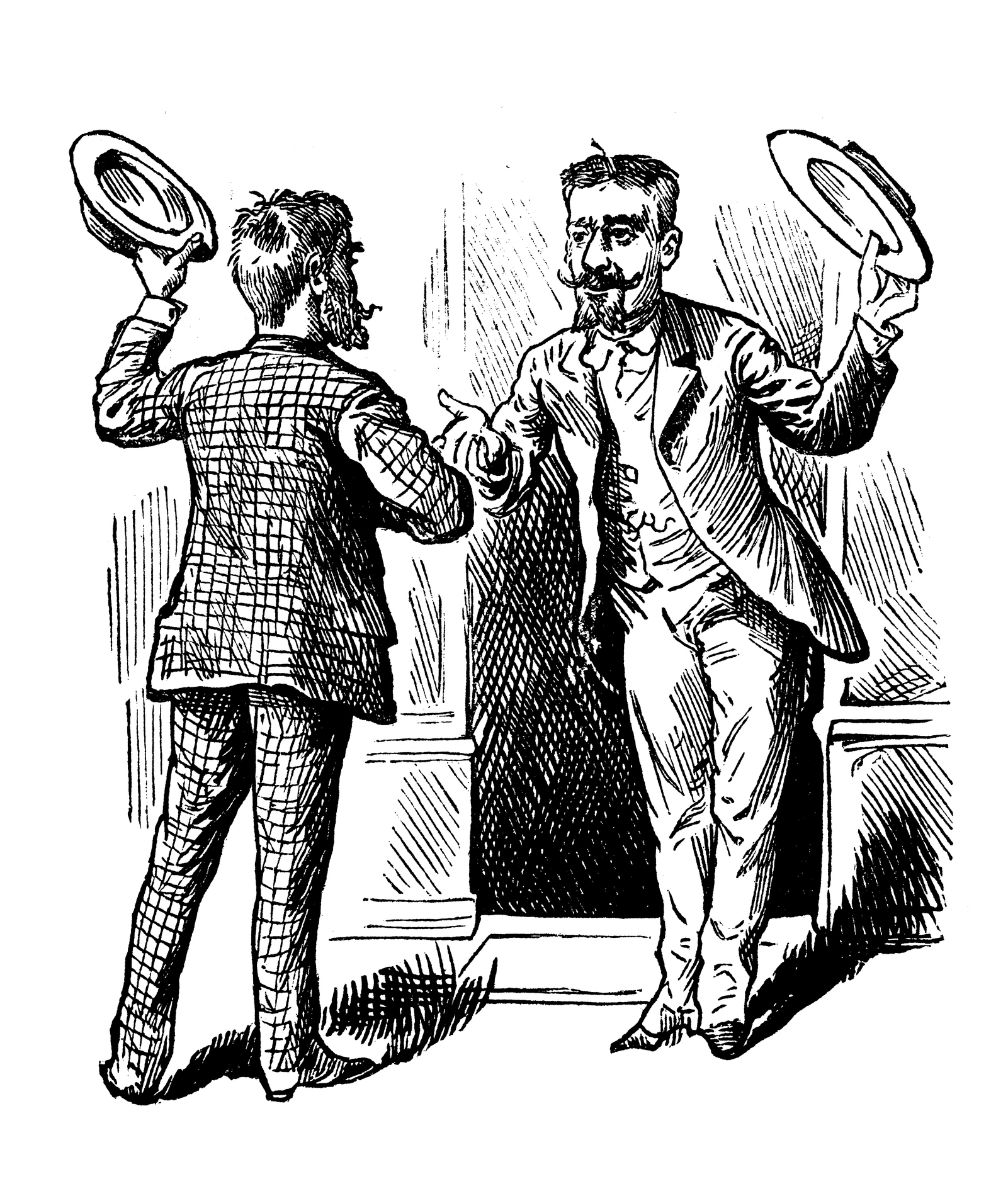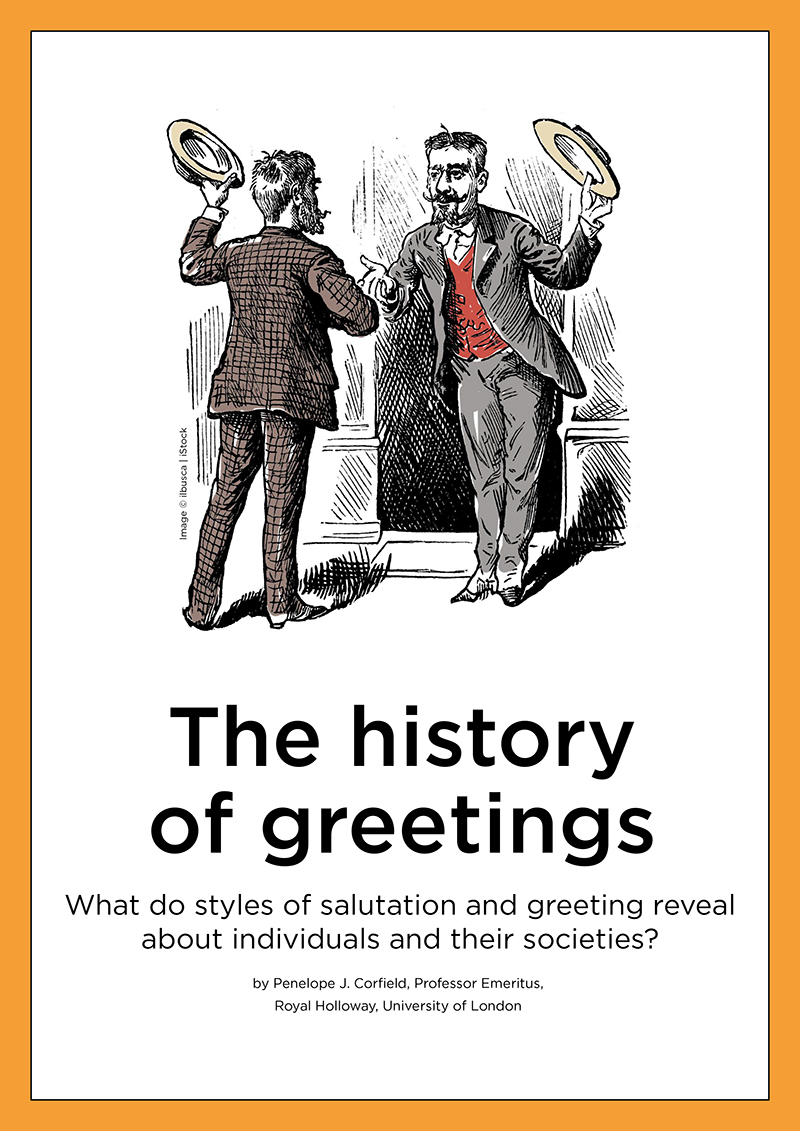What do styles of salutation and greeting reveal about individuals and their societies?
Styles of salutation are adaptive, not static – and they reveal much about both individuals and their societies
Daily greetings between fellow humans go on all the time; and they are very informative. Man people will follow the conventions of the societies in which they live. But others adapt the norms or even borrow different salutations from other cultures. And, in all cases, greetings can be delivered not only politely or warmly but also rudely or crudely. The social dynamics of human interactions remain ever-complex and ever-fascinating.
Studying the history of greetings
Fleeting gestures of daily greetings between humans are hard to study. The reason is not that greetings go unnoticed at the moment of meeting. Yet people rarely keep a record of the frequent and fleeting gestures that they both use and encounter – thus creating a major challenge for historians.
Research projects focusing on salutations require considerable time and patience. Before the spread of extensive literacy, the sources were exceptionally thin. Even in eras when more people could leave written records, the sources remain scattered and fragmentary. Passing comments may survive in letters, diaries, novels, plays, legal depositions, and travellers’ accounts, while some visual representations appear in pictures and sketches.
All sources, however, need to be assessed carefully. Witnesses may be either intentionally or unintentionally misleading. They may be biased, fantasising, or simply joking. Or, in the case of travellers, they may report something as normal that was, in fact, highly unusual – or vice versa. Hence, the historian’s perennial motto: Vigilance.
Salutations without bodily contact:
Raising hats and lowering heads
Bowing the head in greeting remains one of the major forms of salutation that do not entail making bodily contact with others. Historically, that gesture was widely used across Europe before the eighteenth century – and it has by no means disappeared completely.
In the most formalised version of the ritual, a man, when honouring his social ‘superiors’, would advance his right leg, over which he bowed deeply whilst ceremonially removing his hat.
The principle behind this manoeuvre is that the head represents the individual. Therefore, those of indisputably high status hold their heads upright at all times, whereas the comparatively ‘lowly’ literally lower their heads – and remove their hats, which symbolise the head. Meanwhile, non-elite women held out their skirts and made a deep curtsey while also bowing their heads slightly.
Bodily prostration
An extreme version of this principle is seen in salutations, which require complete bodily prostration. Not only the head but the entire body is flattened on the ground, symbolising reverent obedience. A somewhat easier manoeuvre to execute takes the form of kneeling and then bending the body forward until the forehead touches the ground. This action is adopted in some forms of religious worship, including Islam and Jainism: the individual ego surrenders before divine authority.
Bodily prostration also has a secular history. Traditionally, the subjects of China’s Emperors would ‘kowtow’ to them. A full kowtowing, on the grandest of occasions, involved the ‘lesser’ mortal kneeling down three times and knocking the head on the ground nine times. But less elaborate variants were also deployed – for example, when people met imperial officials – or when youngsters paid homage to older relatives at special family events, such as weddings. (Today kowtowing has been adapted into a deep ceremonial bow).
Varying and Challenging Conventions
Greetings can be offered gracefully or rudely. On occasion, a few daring individuals could openly challenge social conventions by refusing outright to show personal deference, even to the highest of the land.
One instructive case was reported in Britain in 1630. A Puritan oatmeal-maker of modest social status was summoned before King Charles I and his senior advisors assembled in the Privy Council. But: shock, horror! The oatmeal maker refused to remove his hat. Bolstered by his radical Protestant faith, he resolutely declined to honour the Anglican Bishops who were in attendance. They expostulated that they were there as Privy Councillors. Whereupon the oatmeal maker smartly replied:
‘Then, as you are Privy Councillors. I put off my hat.
But, as ye are Rags of the Beast [lackeys of the Devil],
lo! – I put it on again!’
Few cases were as dramatic. It took some nerve – and strong motivation – to flout convention before the King and all his ministers. But, less dramatically, all conventional salutations are subject to adaptation and variation daily.
Salutations entailing bodily contact:
Hugging
At the other end of the spectrum of greetings styles, there are conventions that do permit close bodily contact. For example, salutations in the form of hugging and/or kissing – with varying degrees of intimacy – are widely used, especially by young people, in today’s less overtly hierarchic societies.
However, there are many variants, depending on the circumstances. So, the proverbially all- enveloping Russian hear-hug is jovially used between close friends and family in Russia – but not when greeting officialdom, senior politicians, or strangers of unknown status.
Kissing as a daily salutation
Kissing as a form of greeting also takes many forms. It indicates friendship and affectionate familiarity. Yet there are also limits on its public expression.
Comparatively remote is the ‘air-kiss’, when people kiss the air next to the other person’s cheek. Closer contact ensues when kisses are planted directly on the cheek. But these are often little pecks or ‘formula kisses’: mwah! mwah! They are not expected to be sensual or lascivious. The same applies to hand-kissing as a regular salutation. This form of greeting is also expected to remain decorous.
Meanwhile, there are cultural variations in the number of expected welcoming kisses: the total ranging from one to two to three or (rarely) four, alternating from cheek to cheek.
Adding to these social complications, some cultures are happy for non-family men and women to kiss upon greeting. Others are not. Some cultures are equally happy for men to kiss their fellow men upon greeting. Others are not.
A kiss too far
Another example, this time from eighteenth-century Britain, shows how conventions of salutation were sometimes challenged in private life as well as in public performance. The scene was a party for various friends and family, hosted at his home by the prosperous musician Dr Charles Burney in May 1775.
At the end of the gathering, his young daughter Fanny Burney was saluted by her grandmother, who gave her ‘according to custom’ a grandmother’s kiss and blessing. Then, somewhat to Fanny’s displeasure, the other ladies present did likewise. Finally, a visiting young man, who had paid great attention to her all evening, gave her, before all the company, ‘an ardent salute’.
Yet Fanny Burney clearly did not enjoy his sensuous kiss. Instead, she wrote in her diary that his actions were brash and uncouth.
So, when the young man applied to Dr Burney the next day, seeking to become his daughter’s suitor, Fanny urged her father to reply No! He duly did so. The young man had badly miscalculated. Breaking the conventions to express passion by no means always worked.

A globally acceptable compromise between closely touching and non-touching salutations
Shaking an outstretched hand
Over time, and completely informally, a global compromise salutation is emerging in the form of the hand-shake. As a style of greeting, it is friendly, egalitarian and non-hierarchic. Yet, it does not entail close bodily contact with the recipient of the hand-shake. Indeed, when the arms of both parties are fully outstretched, shaking hands can be undertaken with full pomp and formality.
Full details of the complex history of the handshake are explained in a previous article. The gesture has not been accepted without some controversy. And it should be noted that to this day, people in some religious traditions do not accept hand-shakes between men and women outside their close families.
Globally, however, hand-shaking is becoming the international salutation of choice. It is known and accepted across very many (though not all) cultures. It has long had a significant role in international diplomacy when a hand-shake is taken as a pledge of peace. At the time of pandemics (as in the first wave of Covid in 2019-22), people were advised to avoid shaking hands, for health reasons. Thereupon, some rash journalists announced the permanent demise of this salutation. But they are daily being proved wrong.
Hand-shaking has not only a long international past – but a long-extending international future, too.
Social negotiation
In closed societies with little population movement, the styles of daily greeting can remain unchanged over long periods of time. People still use conventional salutations casually or formally, according to circumstances and personal choice. However, the shared framework of expectations does not vary significantly.
By contrast, in globally open trading societies – as found across the world today – there are multiple options in terms of salutations. The process of deciding mutually what greetings to use takes place very quickly when people first meet. It’s called an (unspoken) social negotiation. Close? Distant? Informal? Formal? Touching? Non-touching? In a world where people are increasingly on the move, global citizens have to remain on their toes. It keeps life ever-interesting.
Daily greetings are adaptive, not static.
Penelope J. Corfield studies the social dynamics of greetings, both past and present. Such gestures are not usually learned from guides to good conduct or from etiquette books. These sources do reveal what is or was expected. But humans often vary the conventions that they earned as children – and those living in open trading communities may adapt greetings from other cultures. As a result, rituals of hand-shaking – bowing – hugging – air-kissing – nose-rubbing – pressing one’s hands together before the heart (‘namaste’) – hitting another’s hand in a ‘high five’ – and other variants – collectively open windows upon human history and personal choices within that.


